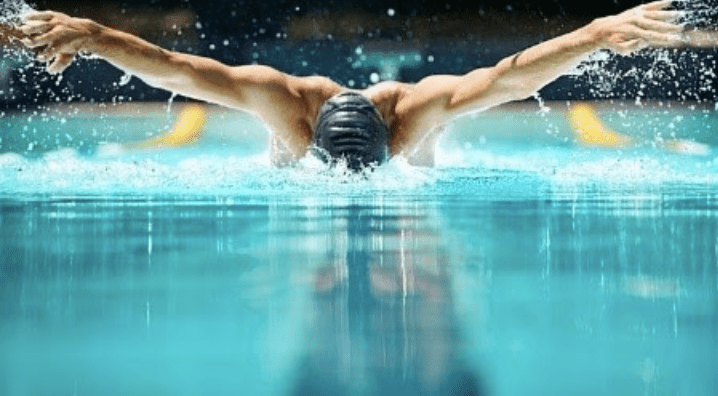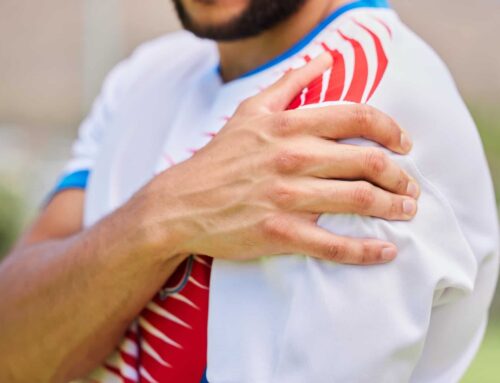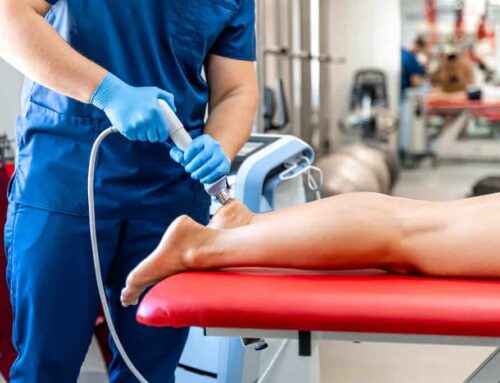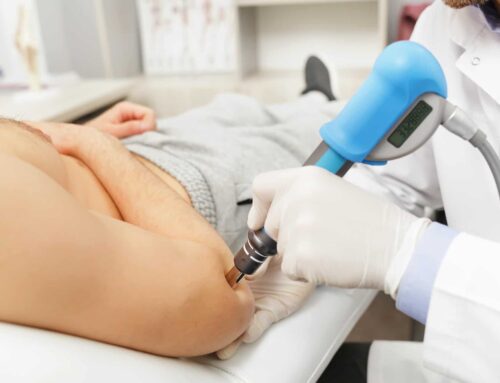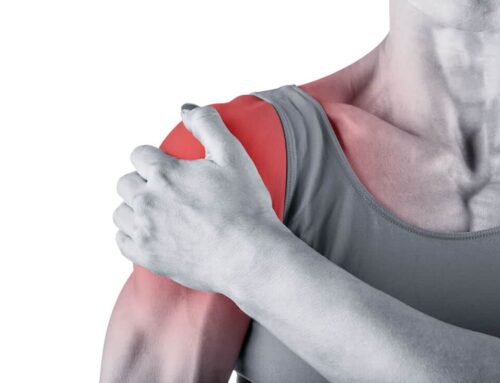Swimmer’s shoulder is a term used to describe a variety of painful shoulder conditions that develop overtime from the repetitive motion of swimming. Shoulder pain while swimming can be caused by numerous factors – muscle strength, muscle coordination, or flexibility. Oftentimes, it is a combination of all three.
Anatomy
Your shoulder is a ball and socket joint, which means it inherently has some instability and has a large range of motion. Your rotator cuff muscles act as stabilizers to keep your shoulder in its socket and help it roll when you lift your arm. Any sort of weakness or muscle misfiring can cause the humerus to translate and shift in your socket instead of roll, causing pain.
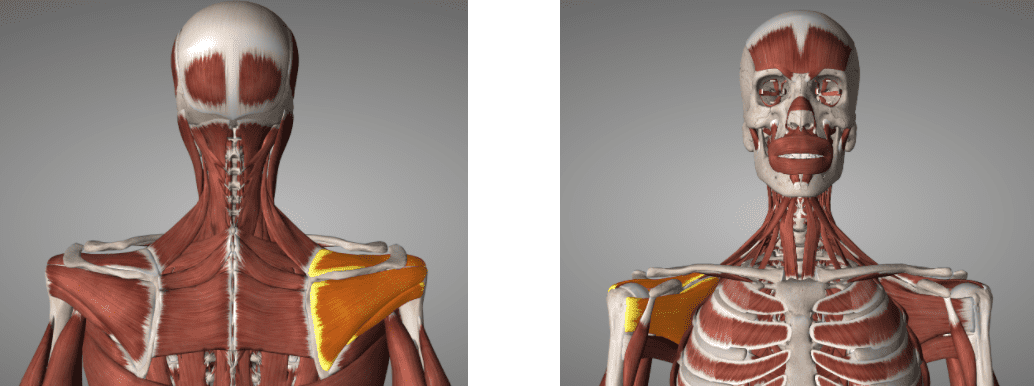
The muscles of the rotator cuff: supraspinatus, infraspinatus, teres minor (left), and subscapularis (right)
Pathology
Swimmer’s shoulder is a catch-all label for several different types of shoulder pain and pathology. The most common pathologies that fall under the classification of swimmer’s shoulder are:
Acromioclavicular joint impingement
The acromioclavicular joint is part of the shoulder complex and must move as we raise our arm overhead. Pain occurs (typically at the top of the shoulder) if the rotator cuff muscles surrounding it are weak or the joint itself is stiff. You may feel a clicking or grinding with pain as you raise your arm.
Supraspinatus tendinopathy
The supraspinatus muscle is a rotator cuff muscle that runs underneath your acromioclavicular joint. Oftentimes, it can experience friction from the joint moving improperly, causing irritation of the supraspinatus tendon and pain. The pain is often at the top of your shoulder and can radiate down your arm.
Poor shoulder muscle strength and coordination
There are 17 muscles that connect to our shoulder. All of them must contract in a specific pattern and force to effectively move our arm. Pain can result when any of these patterns are out of sync or there is a muscle strength imbalance. Because there are so many muscles that connect to our shoulder, you may experience your pain in the front, top, or back of your shoulder or even in your midback.
Treatment
All of our muscles in our body are interconnected. Very rarely does swimmer’s shoulder result from just one of the above pathologies and is often a combination. Treatment, therefore, must involve addressing all aspects. You may have tried stretching your arm and shoulder or strengthening your rotator cuff muscles. However, muscles from our shoulder connect to various other structures in our body and even to our pelvis, in the case of the big muscle the latissimus dorsi. Therefore, it is imperative to take a step back and look at the bigger picture of what may be causing your swimmer’s shoulder. Muscles generate maximal force at a determined length. If they are stretched or contracted, they are unable to contract appropriately, which forces other muscles to try to take over. Subsequently, these substituting muscles become tight and are unable to perform their primary function accordingly. This results in muscle weakness, poor muscle coordination, and pain. Therefore, treatment must address:
- Muscular tightness
- Muscular weakness
- Poor muscle coordination
- Shoulder, trunk, and full body movement
- Joint mobility
If treatment lacks any of these above, it does not address all of the issues that are contributing to your shoulder pain. Pain is a symptom; not a cause. If you have pain in your shoulder, the treatment must consist of not only getting rid of your pain, but finding and correcting the root cause.
This is why traditional physical therapy for swimmer’s shoulder often results in residual symptoms or return of symptoms. Simply addressing the pain without solving the problem will not, unfortunately, produce lasting change.
If you have swimmer’s shoulder and are unable to decrease your pain or pinpoint the cause, speak to an expert regarding your shoulder pain and how to create lasting solutions. Simply click on the link below to fill out a short form and arrange a call to speak to one of our doctors of physical therapy and get back to the activities you enjoy.
Swimmer’s shoulder is a term used to describe a variety of painful shoulder conditions that develop overtime from the repetitive motion of swimming. Shoulder pain while swimming can be caused by numerous factors – muscle strength, muscle coordination, or flexibility. Oftentimes, it is a combination of all three.
Anatomy
Your shoulder is a ball and socket joint, which means it inherently has some instability and has a large range of motion. Your rotator cuff muscles act as stabilizers to keep your shoulder in its socket and help it roll when you lift your arm. Any sort of weakness or muscle misfiring can cause the humerus to translate and shift in your socket instead of roll, causing pain.

The muscles of the rotator cuff: supraspinatus, infraspinatus, teres minor (left), and subscapularis (right)
Pathology
Swimmer’s shoulder is a catch-all label for several different types of shoulder pain and pathology. The most common pathologies that fall under the classification of swimmer’s shoulder are:
- Acromioclavicular joint impingement
The acromioclavicular joint is part of the shoulder complex and must move as we raise our arm overhead. Pain occurs (typically at the top of the shoulder) if the rotator cuff muscles surrounding it are weak or the joint itself is stiff. You may feel a clicking or grinding with pain as you raise your arm.
- Supraspinatus tendinopathy
The supraspinatus muscle is a rotator cuff muscle that runs underneath your acromioclavicular joint. Oftentimes, it can experience friction from the joint moving improperly, causing irritation of the supraspinatus tendon and pain. The pain is often at the top of your shoulder and can radiate down your arm.
- Poor shoulder muscle strength and coordination
There are 17 muscles that connect to our shoulder. All of them must contract in a specific pattern and force to effectively move our arm. Pain can result when any of these patterns are out of sync or there is a muscle strength imbalance. Because there are so many muscles that connect to our shoulder, you may experience your pain in the front, top, or back of your shoulder or even in your midback.
Treatment
All of our muscles in our body are interconnected. Very rarely does swimmer’s shoulder result from just one of the above pathologies and is often a combination. Treatment, therefore, must involve addressing all aspects. You may have tried stretching your arm and shoulder or strengthening your rotator cuff muscles. However, muscles from our shoulder connect to various other structures in our body and even to our pelvis, in the case of the big muscle the latissimus dorsi. Therefore, it is imperative to take a step back and look at the bigger picture of what may be causing your swimmer’s shoulder. Muscles generate maximal force at a determined length. If they are stretched or contracted, they are unable to contract appropriately, which forces other muscles to try to take over. Subsequently, these substituting muscles become tight and are unable to perform their primary function accordingly. This results in muscle weakness, poor muscle coordination, and pain. Therefore, treatment must address:
- Muscular tightness
- Muscular weakness
- Poor muscle coordination
- Shoulder, trunk, and full body movement
- Joint mobility
If treatment lacks any of these above, it does not address all of the issues that are contributing to your shoulder pain. Pain is a symptom; not a cause. If you have pain in your shoulder, the treatment must consist of not only getting rid of your pain, but finding and correcting the root cause.
This is why traditional physical therapy for swimmer’s shoulder often results in residual symptoms or return of symptoms. Simply addressing the pain without solving the problem will not, unfortunately, produce lasting change.
If you have swimmer’s shoulder and are unable to decrease your pain or pinpoint the cause, speak to an expert regarding your shoulder pain and how to create lasting solutions. Simply click on the link below to fill out a short form and arrange a call to speak to one of our doctors of physical therapy and get back to the activities you enjoy.


